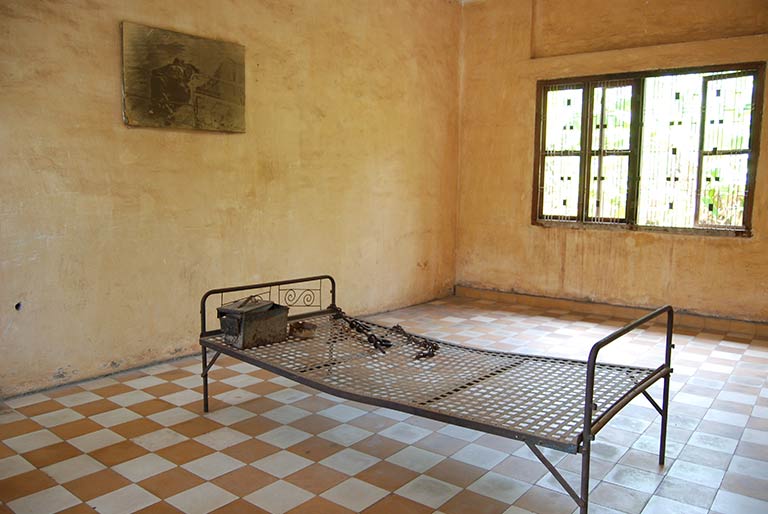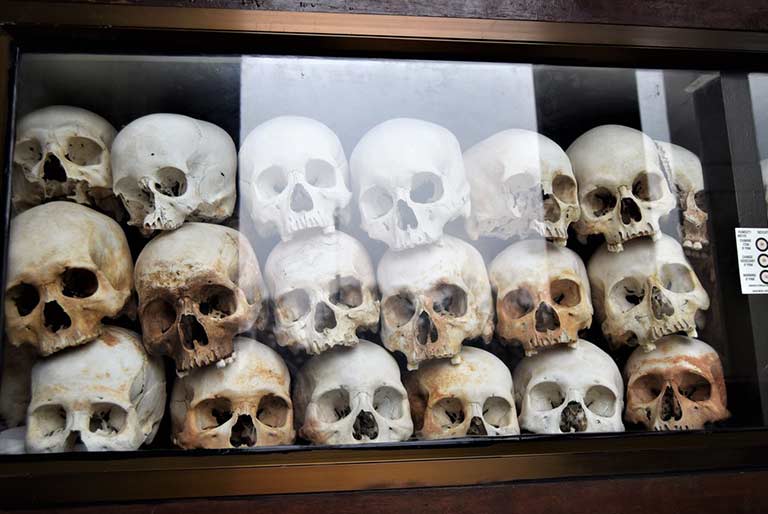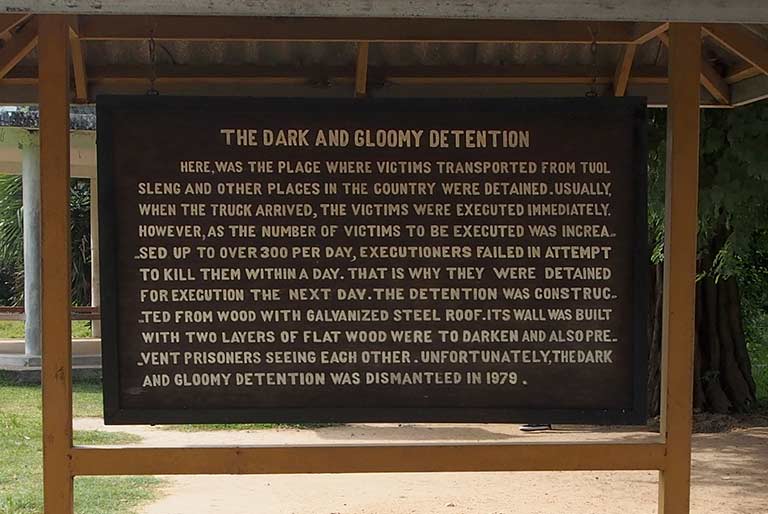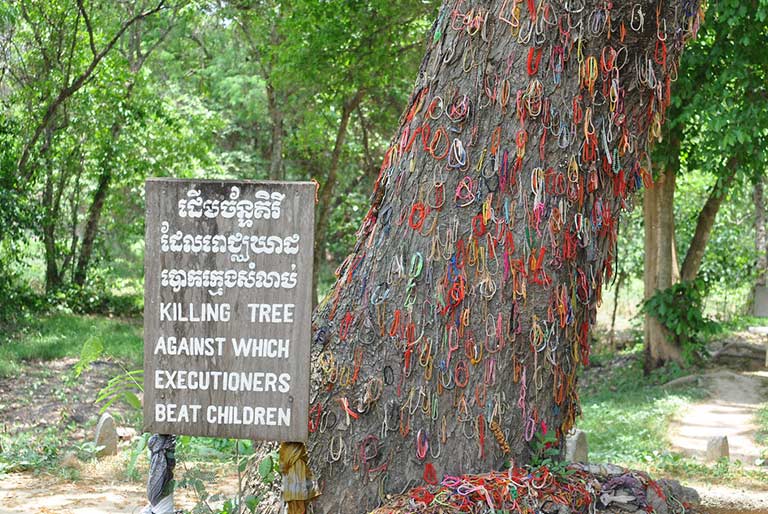Back to Homepage / Blogs / Jan 2020
Khmer Rouge Killing Fields
One of the darkest times in the history of the modern era took place in Cambodia between 1975 and 1979, following immediately after the end of the Cambodian Civil War (1970–1975). This was when the Pol Pot-led Khmer Rouge ruled the country. Being promised peace in the country after years of civil uprising and secret bombing exercises from America, who was embroiled in a war with Vietnam, Cambodians took to the streets to ingratiatingly welcome the soldiers during the fall of Phnom Penh on April 17, 1975.
However, the ideal and peaceful situation never came. Cambodians were soon rounded up and sent to the countryside as part of the plans of the communist regime to create an agrarian society. All personal possessions of Cambodians were confiscated, money was abolished, and family ties severed. The almighty Angkar set harsh laws. The new law saw the population sent to work on the land under shockingly distressing conditions.
The Killing Process
The execution process of the Khmer Rouge regime, for small or major political crimes, started with a warning from the Angkar, the then the Government of Cambodia. Cambodians getting more than two warnings were transported for "re-education," which meant living under near-death conditions. People of Cambodia were often encouraged to concede to Angkar and confess their "pre-revolutionary lifestyles and crimes."
These confessions would include crimes like carrying out some free-market activity, having had a connection with a foreign source (such as an American missionary, government agency, or international relief), or having any contact with any foreigner or with the world outside at all. After the confession, these people were told that Angkar would forgive them and start everything on a clean slate. These people were then taken away to Tuol Sleng or Choeung Ek for excessive torture and/or execution.

Detension and torure room, Security Prison 21 (S21)

Toul Sleng Genocide Museum in Phnom Penh
Toul Sleng is an StSi-21 Genocide Museum in Phnom Penh and was the central political prison during the Khmer Rouge regimen. This is the place where suspected foes of Angkar were sent. The number of Cambodians detained at S-21 increased as the paranoia of Pol Pot and the top commander rose. Once inside the prison, detainees were either tortured to death or transported to nearby Choeung Ek for "re-education," which meant execution. About 12,273 Cambodians were detained at Toul Sleng. There are only seven known survivors.
Choeung Ek, as many might think, isn't any orchard in Cambodia. This place has acted as the primary killing centre of Khmer Rouge. Horrific reminders of those dark times can be found at every step, making a trip to Choeung Ek a soul-shaking one. Made up of 129 communal graves, 43 of them have been left untouched. Even today, visitors can witness the many bone fragments, teeth, and scraps of bloodied cloth in glass containers.
The executed Cambodians were buried in mass graves in and around these areas. To avoid excessive use of ammunition, Khmer Rouge often conducted the execution using spades, poison, or sharpened bamboo sticks.

Choeung Ek mass graves

The Buddhist Memorial Stupa at Choeung Ek
The Buddhist Memorial Stupa at Choeung Ek has proof of knives, bayonets, wooden clubs and hoes for farming and curved scythes used to kill victims. There are also images of destroyed skulls as evidence of these atrocities. In some cases, the infants and children of adult victims were smothered by having their heads smashed against the trunks of Chankiri trees. They were then thrown into large pits along with their parents. The premise of these practices was "to stop them from growing up and avenging the death of their parents."
An area, the size of a soccer field, amidst farmland, contain mass graves, of perhaps twenty-thousand Cambodians, many of whom were tortured before being killed. The bordering trees bore nooses for hanging people. Some victims were asked to dig their own graves. Their weakness in doing so often implied that they were not able to dig very deep. The Khmer Rouge soldiers who carried out these executions were mostly young men or women belonging to peasant families.

The Killing Fields Choeung Ek

Skulls from the killing fields
End of the Khmer Rouge Regime
An invasion by Vietnam eventually forced the atrocious Khmer Rouge to relinquish its control of the central government of Cambodia in 1979. Most leaders of the group went into hideouts in Thailand and Western borders of Cambodia. The group even gave up Communism in a bid to garner international support. As part of a government-in-exile, they were able to retain seats in Cambodia's United Nations for years. However, years of constant fighting with the government tore down the group. Following a peace agreement in 1991, and democratic elections in 1993, the monarchy was restored in Cambodia.
During the 1990s, the Khmer Rouge was a spent force by the end of the combat. Pol Pot himself died in 1998, never truly saying what motivated the years-long reign of terror. Nuon Chea acted as his deputy and "Brother Number Two" to Pol's "Brother Number One." Khieu Samphan assumed the seat of the head of state for Democratic Kampuchea between 1976 and 1979. Both Khmer Rouge leaders have denied the crimes of alleged atrocities against humanity. Moreover, both are believed to be planning court appeals. It is unclear if they will reach a final verdict for charges of genocide.
Prosecution of anti-human crimes
Between 1975 and 1979, Pol Pot and his Khmer Rouge soldiers killed about 1.7 million Cambodians, which is nearly 21% of the country's population. In 1997, the Cambodian government requested the assistance of the United Nations in setting up a genocide tribunal. It took them nine years to agree to the shape and structure of the new court, which was set to be a hybrid of Cambodian and international laws before the judges swore in 2006.
After that, the investigating judges were given the names of five possible suspects of these crimes by the prosecution on July 18, 2007. On September 19, 2007, Nuon Chea, who was second in command of the Khmer Rouge and the most senior surviving member of the army, faced severe charges for committing war crimes and crimes against humanity. He appeared before Cambodian and foreign judges at the special genocide tribunal and was received a life sentence on 7 August 2014.

Pol Pots, Leader of the Khmer Rouge

Khmer Rouge 'brother number two' Noun Chea
On July 26, 2010, Kang Kek Lew (also known as Comrade Duch), the director of the S-21 prison camp, was charged for crimes against humanity and imprisoned for 35 years. His sentence was later reduced to 19 years since he had already spent 11 years in prison. However, on February 2, 2012, the Extraordinary Chambers in the Courts of Cambodia extended Kang Kek Lew's sentence to life imprisonment.
The long, challenging path of the tribunal had already frustrated many people in Cambodia for years. Much of this frustration comes due to opposition from current Prime Minister Hun Sen, who was a former Khmer Rouge soldier himself.
The tribunal was first recommended in 1999, but delays meant that the trial didn't start until 2011. Out of the four senior leaders appointed at the beginning of the trial, two of them initiated the prosecution. They were Former Foreign Minister Ieng Sary (who however died in 2013) and Social Affairs Minister Ieng Thirith, who was deemed unfit for trial the previous year. The tribunal has also dealt with another case, which related to prison director Kaing Guek Eav. The court sentenced him to life imprisonment in 2011. However, the prosecution continues to remain slow, and thousands of former Khmer Rouge soldiers are still roaming freely.
Remembrance
The government transformed Choeung Ek into a memorial site and tourist place in a bid to educate young Cambodians – and also the world – about everything that happened there. It also serves as a way to commemorate all those people who lost their lives to the Khmer Rouge regime. May 9 of every year marks a memorial ceremony at the Killing Fields.
Each year, survivors and their relatives, officials, students from across Phnom Penh, and other Cambodians come together at the Buddhist Stupor to remember the departed souls.

Choeung Ek, The Killing Fields

Killing Tree against which executioners beat children
The Killing Fields as a Tourist Site
While remembering the past, and also learning from it, there is a global debate about whether making profits from dark tourism sites such as Choeung Ek is educational or exploitative. No matter what, hundreds of Cambodians presently make a living by guiding tourists and visitors through the killing fields. Many guides tell their distressing personal stories of how they survived the torture, often by becoming refugees in the neighbouring country of Thailand.
There's an audio tour that guides tourists and visitors around the genocide-related site and gives shocking stories from survivors, correctional officers and executioners. A trip to the Killing Fields is nothing less than harrowing and emotional. Nonetheless, it offers a compelling peek into a fraction of the atrocities that took place across Cambodia under the mass genocidal regime.
Another infamous site of genocidal torture is the Tuol Sleng Museum of Genocide in Phnom Penh. Once a high school, it became a torture camp, prison and execution centre used by Khmer Rouge soldiers. Today, this site looks benign, with lines of palm trees and clean grass lawns set in a suburban landscape. From the outside, Tuol Sleng looks like any other school in the world. But going inside, one can see weapons of torture, skulls, bloodstains and photographs of scores of Cambodians who were killed.
The scene just outside the Tuol Sleng Museum is also soul-crushing. Amputees of all ages beg close to refreshment and souvenir shops where tourists meet. The Khmer Rouge regime may be over long ago, but many of the land mines are still killing and maiming.
Visitors to the killing field of Cambodia are requested to be respectful during their trip and remember the essence of the place. They are requested to dress appropriately, avoid clicking disrespectful snaps in front of skulls or bones, as well as avoid drinking, smoking, or eating while touring.